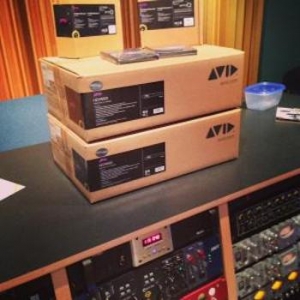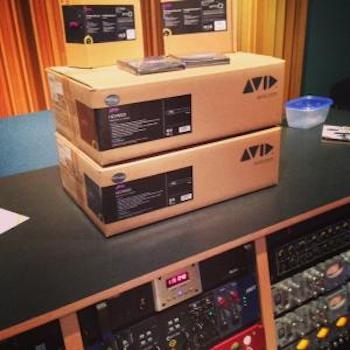It only took 6 years of threatening, 120 feet of 12 channel Fiber Optic trunk, 1 LC and 2 SC Cartridges, an SSL MADI X8 router, 6 Yamaha MADI Cards, an Avid MADI HD interface, pulling out 32 AES install cables and snakes and... okay, it took a lot. But, thanks to the efforts of a crew of Recording and Production upperclass students, a necessary ProTools upgrade hardware and software and a lot of patience from the Physical Plant Networking crew, Studio A, C, and the Machine Room are now upgraded to the MADI infrastructure. This begins the long and fruitful process of bringing the fourth floor studios up to the latest Pro Tools system as well as increasing the flexibility and track counts plausible in the facility.
MADI stands for Multichannel Audio Digital Interface and comes in two formats: coaxial and fiberoptic. Most of the studio will be operating on the fiberoptic format with the coaxial format helping with the interfacing of the Avid MADI HD interfaces. The format also allows for track counts of 64 channels per fiberoptic cable or 56 channels, depending on which format you choose. The track count at double rate halves, providing 32 ins and outs at 88.2 kHz and 96kHz. MADI has been around since 1991 – with updates by the Audio Engineering Society committees in both 2003 and 2008 – and has found a home with high profile manufacturers of large format consoles such as Yamaha, DigiCo, SSL, Sony, and Euphonix (to name a few). MADI can also be found on top end AD/DA converters like RME, SSL, and Antelope Audio, providing large faciities and broadcast companies the opportunity to convert their analog signals to digital for larger numbers of channels and transfer those large numbers of digital audio feeds down a single fiber optic cable. AES3, in comparison, runs 2 channels of digital audio on a twisted pair of copper cables and ground wire, thereby requiring 32 physical two conductor cables to equal the track count of a single fiber optic cable of MADI. If you want bidirectional communication with AES3, your physical cable count doubles to 64 cables.
So why the change? Studio A's ProTools rig resides in the Machine Room right next door and, for isolation purposes, the original design of the studio has four 2.5" diameter conduits running into the Studio A alcove on the left side of the control room. The four conduits carry every analog, digital and cat5e/6 cable that connect the two rooms and with 64 AES cables pushed into the conduit, the facility was operating at 70 to 80% capacity for all of our pipes (Physical Plant typically keeps their conduits in other parts of the campus at 30-40% for electric and networking cables). This allowed for 32 channels of digital audio in and out of ProTools, but many projects coming through by students exceeded this track count which required the students to submix portions of their projects in Pro Tools. Providing more connectivity with the Studio A facility was not possible since it was implausible to safely pull any more cabling through the conduits without damaging other cables or worse getting cabling stuck IN the conduit. In contrast, the twelve channel fiber optic trunk that was installed to replace the AES cable run from A Studio to the Machine Room is the width of 4 physical copper cables of AES. That's 12 channels of MADI, or 12 x 64 channels of digital audio, or 768 channels of digital audio... we should be good for a while.
Studio C in contrast moved to MADI on the first floor as a result of Apogee entropy. That's a fun way to say our Apogee AD-16x and DA-16x units fried themselves – they generate a lot of heat. Antelope Audio just introduced the Orion 32 in the market last year and we had already purchased one unit for the Rosen Concert Hall recording setup. ALL of the Concert Recording Staff loved it! The unit offers 32 channels of AD/DA in and out of a single rack unit and it ran on a USB 2.0 cable... not even a 3.0. The Orion 32 replaced 4 Apogee units taking up 8 rack spaces (1 for the unit and 1 for air around the units!). In an effort to reduce heat and noise, we pulled the computer out of C Studio and installed it in the Storage Room next door, connected a Gefen Dual KVM extender and upgraded from Pro Tools 9.6 to Pro Tools 10/11 HD native with an Avid MADI HD interface. We are now capable of 64 I/O on the Amek Media 51 console.
Futureproofing the studio is implausible as formats, software, computers, and infrastructure constantly change in the industry. The plan for the MADI infrastructure to be installed was done largely with the idea that, as an educational institute, we should expose our students to as much information and provide them a variety of different experiences that they will be encountering in the industry. The acquisition of ALL of our equipment follows this philosophy. Our infrastructure provides an opportunity for us to engage the students with a more complex and varied design that allows them to work hands on with outboard gear, software, patchbays, and digital routing, meeting their ever demanding creative processes.
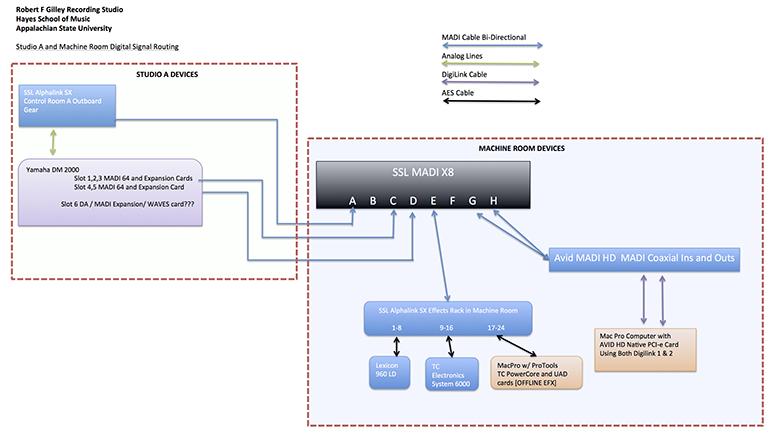
Above: MADI signal flow for the A Studio to the Machine Room
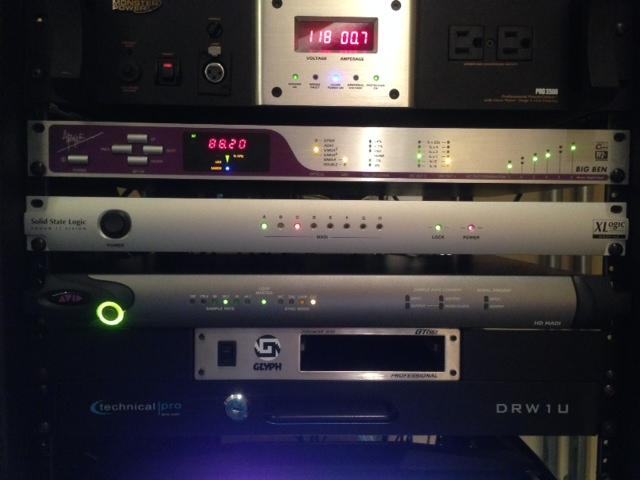
Above: The newer, cleaner, more powerful Machine Room Rack for Studio A.
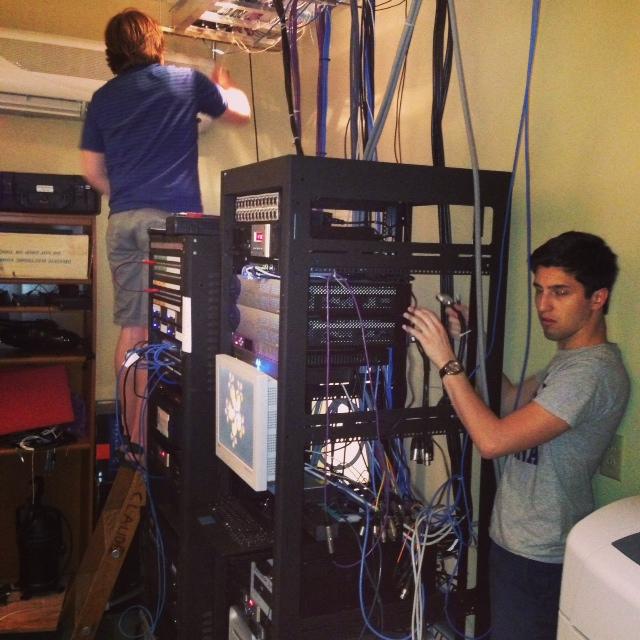
Above: So there were 64 channels of AES cable stuck in this conduit plus a few cat5e cables. Thanks to the weight and mass of many of our students we were able to clean out the pipes from this old technology so that Physical Plant could pull our new sleek 12 channel Fiber Optic trunk capable of 768 channels of MADI digital audio.
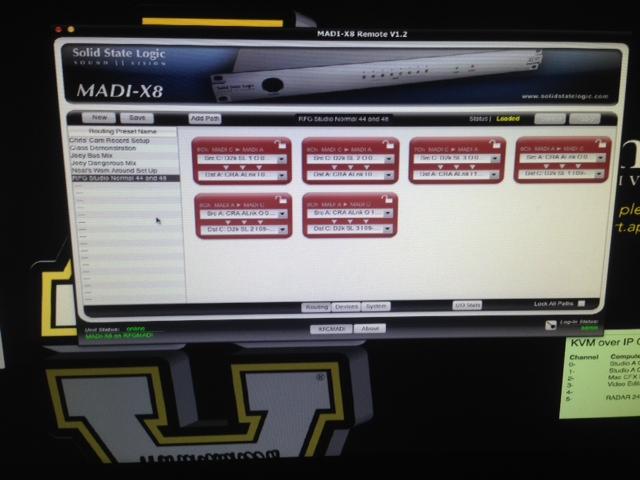
Above: The SSL routing software replaced all of our AVP long frame patch bays in Studio A allowing us to route by clicking on the paths and adding sources sent to destinations. We setup the software to recognize sources and destinations as 8 channel groups or Octets as well as a few larger groups. This allows us to connect 32 patch cables within two clicks... very cool.
Links
